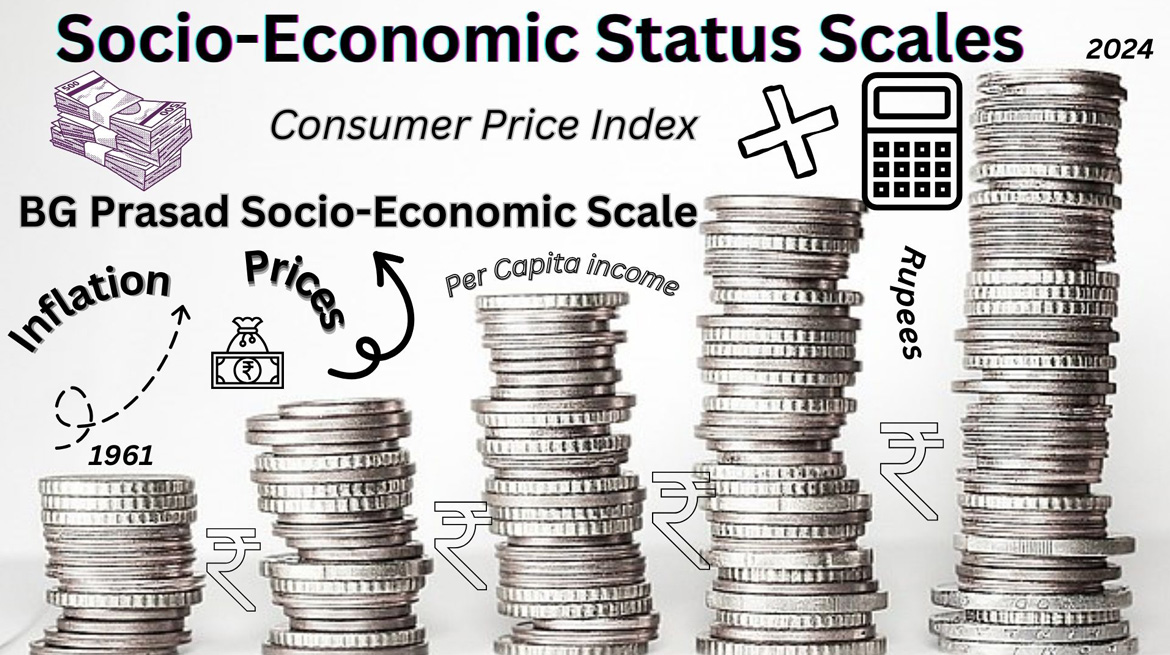I have been planning since long time to write this blog but couldn’t make time. The sudden announcement of a bumper prize by IAPSM egged me to put my pen to paper and vie for the prize. The topic of my blog is rather mundane, but making boring things interesting in our specialty is nothing short of winning the prize.
What is socio-economic status?
Socioeconomic status (SES) has been defined as a construct that represents the social and economic background of an individual or group (1).
Why is knowing socio-economic status important?
Socio-economic status is an important determinant of health and disease, as also accessibility, affordability, and utilization of health services (2).
How do we measure socio-economic status in India?
Several socio-economic status scales have been in use in India, namely the BG Prasad socio-economic scale (3), the Kuppuswami scale (4) and several lesser-known others. The BG Prasad socio-economic scale has been the most widely used scale due to its ease of use, as it requires only one parameter, i.e., monthly per capita family income.
What are the challenges in using the BG Prasad socio-economic scale?
There are two downsides to using the BG Prasad scale: firstly, constant updating due to changes in the Consumer Price Index (CPI) every month, and secondly, change in the base year for CPI calculation. The CPI values vary depending on inflation, which results in a depreciation in the value of the Rupee.
What is the usual process to update the BG Prasad socio-economic scale?
Constant updating of the BG Prasad scale can be cumbersome. The process consists of updating the original BG Prasad income values to income values at current rates by accounting for the current CPI value and linking factors for the three base years (1982, 2001 and 2016. This is usually done manually or in an Excel sheet, as shown in the template (Table 1).
Table 1: Template for manual updating of BG Prasad Socio-Economic Scale
| Social Class | Per capita Income (Rupees) (Prasad 1961) | Old value X Multiplication Factor X 2.88×4.63×4.93 (Multiplication factor: CPI/100 = 139.9/100 = 1.399) | Per capita Income current value (May 2024) |
| Class I | ≥100 | 100 X 1.399 x2.88 x 4.63x 4.93 | ≥ 9197 |
| Class II | 50-99 | 50 X 1.399 x2.88 x 4.63x 4.93 | 4598-9196 |
| Class III | 30-49 | 30 X 1.399 x2.88 x 4.63x 4.93 | 2759-4597 |
| Class IV | 15-29 | 15 X 1.399 x2.88 x 4.63x 4.93 | 1380-2758 |
| Class V | < 15 | 15 X 1.399 x2.88 x 4.63x 4.93 | ≤ 1379 |
Can we make the mundane and boring process of updating BG Prasad scale simple and easy?
An app developed by me to makes the process of updating the BG Prasad scale both simple and easy. To my knowledge, there is only one other online tool exclusively for the BG Prasad scale(5).
How does it work? Yes, it does work!
The app, hosted on GitHub, can be accessed freely through the link: https://frederickvaz.github.io/bg-prasad-calculator/ . The app has an embedded link to obtain the latest CPI value (https://labourbureau.gov.in/). On entering the CPI value and assigning the month and year of the entered CPI value, the BG Prasad scale gets instantly updated. Furthermore, the app displays the socio-economic class to which the family belongs.
Post Script: On a cold day in late December, 1961, Mr. Camotim, the richest bhatcar (landlord) in Goa, resting leisurely on his volter (easy chair) said mockingly to Suppandi, “Are nalaika, ieo hanga begina (Hey idiot, come here quick), take this list of twenty items and these hundred rupees, and go buy all the things from Pinto’s posro (store). It should not cost one paisa more than a hundred”. Suppandi set out in right earnest, whistling happily down the narrow, labyrinthine streets of Panaji. Suddenly he was accosted by Bostianv’s bull, Bosco, the reigning champion of many a dhirios (popular bullfight matches). In a flash, having been head butted by Bosco, Suppandi was flung like frisbee landing on the “Galo Barcelos” (A colourful Terracotta hen or cock) on Roghunath’s compound with a shriek “avoi ge!” (O mother!) The galo split into two pieces and Suppandi went instantly into coma. Days turned to months, months to years and years to decades. Unbeknownst to Suppandi, inflation raged and ate up the value of the rupee at such a voracious rate that even Mr. Camotim could not save his mattress stuffed with all hundred-rupee notes. Then, at last Suppandi woke up with a shriek “mummy ge!” Dazed but still unfazed, he went straight to Pinto’s posro, slammed his list on the counter and readied his hundred rupees. Mr. Pinto promptly presented the bill, not a paisa less than ten thousand rupees. Seeing the exorbitant bill, Suppandi collapsed instantly back to coma never ever to wake up again.
To cut the long story short: socio-economic scales based on incomes fall prey to inflation fast. They can, however be resurrected by accounting for inflation with simple measures, and be it a manual calculation or a simple, easy to use calculator app.
(Disclaimer: The popular character Suppandi has been invoked here purely for academic purposes; Amar Chitra Katha LTD holds exclusive rights. The story above is purely a figment of my imagination, any resemblance to anyone still living or still dead, or in a coma is purely coincidental.)
References:
- Villalba CMH. Socioeconomic Status (SES). In: Michalos AC, editor. Encyclopedia of Quality of Life and Well-Being Research [Internet]. Dordrecht: Springer Netherlands; 2014 [cited 2024 Jul 26]. p. 6210–2. Available from: https://doi.org/10.1007/978-94-007-0753-5_2805.
- Kumar P. Social Classification – Need For Constant Updating. Indian J Community Med. 1993;18(2):60.
- Prosad BG. Changes proposed in the social classification of Indian families. J Indian Med Assoc. 1970 Sep 16;55(6):198–9.
- Kuppuswamy B. Kuppuswamy B. Manual of socioeconomic status (Urban). Delhi: Manasayan, 1981.
- Sharma R. Revision of Prasad’s social classification and provision of an online tool for real-time updating. South Asian J Cancer. 2013;2(3):157.





Very useful, simple and easy
Very useful and easy to use. I have shared the link with my students.
Well done it was long overdue. I was looking for someone who is young and more techno savvy to do this task. Another reason for being happy is that I am associated with this classification as reference number 2.